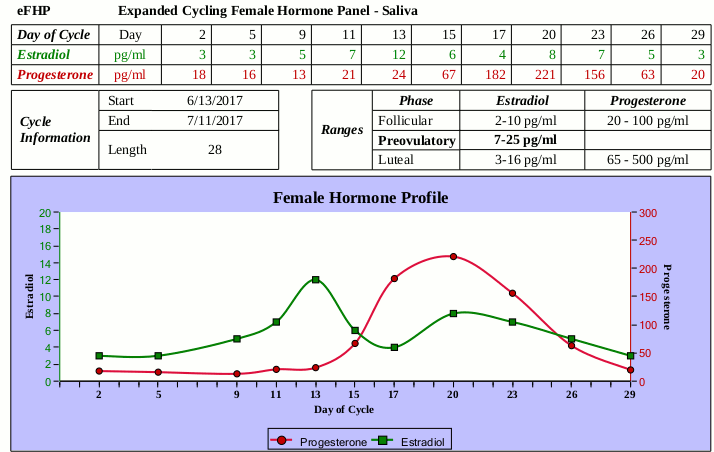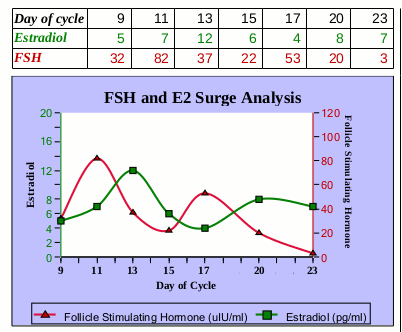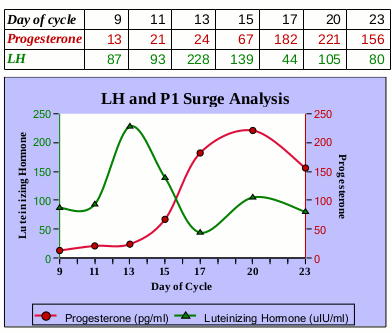Female Hormone Testing In Women of Child Bearing Age
- PMS
- PMDD
- PCOS
- Hormonal Acne
- Endometriosis
- Fibroids
- Infertility
- Luteinizing-hormone
- Follicle-stimulating hormone
- Estrogen
- Progesterone
The pituitary gland is located beneath the brain. It releases luteinizing-hormone (LH) and follicle-stimulating hormone (FSH). These stimulate the ovaries to produce estrogen, progesterone and the maturation of the follicle to prepare the body for pregnancy.
In terms of regular blood testing, if you have a healthy 28 day cycle a good time to get hormones tests is on day 21. This is a high point for both estrogen and progesterone. It is both 7 days after ovulation and 7 days before the start of the next period.
What if you have an irregular cycle? How will your doctor know exactly when you should get your blood test?
The truth is, your doctor will guess. Many times women come into my office with blood work taken at a random time during their period. Their doctor is not even trying to get hormones tested at the best time.
Once the test results come back, your doctor will then make assumptions of what is happening the rest of the month based upon just that one sample.Saliva Testing and the Expanded Female Hormone Panel from Diagnostechs
Saliva hormone testing takes away the guesswork. You do not go a lab for a blood draw. Saliva is easy to collect anytime or place. You spit into a collection tube. Later on the sample is shipped to the lab. This makes it possible to collect multiple samples during the month and chart out your cycle. Look at the following sample results. No more guesswork.Sample report of the Expanded Female Hormone Panel from Diagnostechs

Chart if FSH is properly stimulation surge in estrogen mid cycle

Surge of LH and progesterone response

What hormone test do you want?
- A single sample blood tests which leaves you (and your doctor) guessing?
- A saliva panel that charts out the whole cycle and leaves no need to guess anything?
Why it is important to test FSH and LH
Pituitary versus ovarian problems:
- The pituitary gland in the brain not releasing enough LH and FSH to stimulate the ovaries.
- LH and FSH production is sufficient, but the ovaries are not responding to stimulation.
Testing LH and FSH thus shows if you have either a pituitary, or ovarian problem. These can require different natural treatments and is why the Expanded Female Hormone Panel tests all 4 hormones.
For more information on the Expanded Female Hormone Test please go to diagnostechs website.
Female Hormone Basics
The following is meant to educate clients on when they need to run an Expanded Female Hormone Panel. For most cases I end up running other tests first, or put together a plan based on symptoms and in office assessment.
Estrogens
Estrogens have many functions. This including giving women secondary sex characteristics and preparing the uterus for pregnancy during the cycle.
How does estrogen get the body ready for pregnancy? Increased blood supply, stimulation of cell grow (cellular proliferation) and retention of fluids.
These actions represent what estrogens do to the whole body. Too much causes symptoms related to increase blood supply, cellular proliferation and retention of fluids.
“Estrogen excess” or “estrogen dominance”
You will see both of these terms commonly used. “Estrogen dominance” implies that the issue is not an absolute increase in estrogen, but a relative increase compared to progesterone. Estrogen excess means too much estrogen.
It’s fine to use either term, although “estrogen dominance” is more of a lay term to describe used by many people in alternative health. Estrogen excess is a better medical term.
Common symptoms of excess estrogen (estradiol or xeno-estrogens):
- Mood swings, difficulty thinking
- Cramps and heavy bleeding during period
- Water retention
- Weight gain and fat gain around abdomen, hips and thighs
- Bloating
- Breast pain
- Headaches
- Carbohydrate cravings
- Acne
- Gall bladder problems (estrogen thickens bile)
- Infertility
- Endometriosis
- Fibroids
- Polycystic ovaries
- Allergies
- Autoimmune tendencies
- Breast, uterine, cervical or ovarian cancer
Endogenous and exogenous estrogens
To make things complicated, we don’t just have estrogen. We have several estrogens and they are not all the same.
These are three endogenous estrogens. Endogenous means made by your own body. These hormones are measured on lab tests.
- Estrone
- Estradiol
- Estriol
Estradiol is by far the more potent one.
We also have exogenous estrogens. These come into the body from the outside world.
- Phyto-estrogens from plants such as soy or the herb red clover
- Xeno-estrogens from toxins such as plastic and BPA
- Drug estrogens such as hormone replacement therapy
Phyto-estrogens can have a hormonal effect. However, these are weak. Often they relieve symptoms of excess estrogen by blocking stronger estrogens from cell receptors.
On the other hand, xeno-estrogens found plastics are stronger than estradiol. In fact, one reason for the decreasing age of menarche (a women’s first period) may be the increase of xeno-estrogens in the environment.
[add in image https://en.wikipedia.org/wiki/Menarche#/media/File:Acceleration1.jpg]
Positive effects of estrogens
Estrogens are not all bad. Besides being necessary for development of secondary sex characteristics and pregnancy there aer other benefits:
- Stimulates brain function
- Slows bone loss
- Promotes hydration of tissue
- Increases HDL cholesterol
- Increase vasodilation
This applies for the estrogens your body makes and reasonable levels of phyto-estrogens from foods and herbs.
Xeno-estrogens are all bad. They do not belong in your body. You don’t have any positive effects from toxins such as BPA. Unfortunately, because of pollution we can not totally avoid xeno-estrogens, but we can limit exposure.
Ways to protect yourself against xeno-estrogens:
- Do not store food in plastic. Especially fatty foods such as cheese
- Never heat or microwave food in plastic
- Drink filtered water.
- Avoid plastic water bottles.
- Period detoxification including the use of herbs and supplements to support liver function.
Exogenous estrogens are not all the same
Consider the examples of these three different estrogens:
- The drug-estrogen Premarin comes from horses. The name is short-hand for “pregnant mares urine.” Human have not evolved to metabolize horse hormones and so there are unintended side effects.
- BPA (bisphenol A) is a synthetic plastic that humans have evolved to metabolize. It is an environmental toxin that can cause hormonal side effects.
- Phyto-estrogens exist in many plants. Humans have been eating foods with phyto-estrogens since as long as we have existed. Our bodies have evolved to know how to use and metabolize there estrogens. By blocking estrogen receptors (and possibly other mechanisms) helps symptoms caused by the other estrogens.
Not too long ago almost all women where put on hormone replacement therapy (HRT) for menopause. Eventually they discovered exogenous drug-estrogens cause cancer. There has since been a remarkable decline in HRT and decreasing breast cancer rates.
The toxicity of bad estrogens has led to fear mongering against herbs high in phyto-estrogens. The theory is if xeno-estrogens and drug-estrogens cause cancer, then phyto-estrogens must do as well. For example, if you do an Internet search for “red clover” you will find countless pages warning people about its potential cancer causing effects.
Women have used red clover for hundreds of years. It is an exceptional herb for the female reproductive system, lymphatics, liver and detoxification. No matter how many pages warn you of the dangers from red clover there is one thing you will never find; actual research that proves red clover is dangerous.
Remember, there are many types of estrogens. They are not all the same.
Testing for exogenous estrogens
Blood and saliva hormone tests are only for the estrogens your body makes. No lab tests exists which can measure the estrogenic effect of toxins in your body.
However other labs can help determine the burden of toxicity on the body. These include:
- Hair analysis for heavy metals
- Porphyrin testing for metals and environmental toxins
- The GPL-TOX profile from Great Plains Laboratory is another option
I keep collection kits for all these functional labs in my office. These are not conventional lab which are designed to diagnose specific diseases. Rather, they show underlining toxicity that can cause disease. This is not part of conventional medicine. If you want these sort of tests, you have to go to someone trained in using them. This includes many naturopathic doctor and integrative MDs.
What about progesterone?
Estrogen acts in balance with progesterone. Symptoms of excess estrogen may be from too much estrogen, or progesterone deficiency.
Some common symptoms of progesterone deficiency include:
- Hot flashes
- Night sweats
- Insomnia
- Brain fog and poor memory
- Vaginal dryness
- Headaches
- Wrinkling of skin
- Osteoporosis
Progesterone deficiency may be helped by supplementing with progesterone. However, as a naturopathic doctor who believes that the body can get well when given what it needs, I favor supporting the endocrine system with nutrients and herbs first, before looking to replace hormones. I’m more likely to recommend progesterone for women with menopausal symptoms.
Androgen excess
Other hormonal symptoms may be caused by excess amounts of androgens or “male hormones.” These are DHEA, androstenedione, testosterone and DHT.
Signs of elevated androgens:
- PCOS
- Cystic acne
- Hair loss
- Hirsutism (facial hair on women)
- Loss of period
In cases of androgen excess hormone testing is important. Natural health can help these cases, but it may not be possible to know if hormone levels are improving by symptoms alone.
Testosterone and DHEA are included on the Expanded Female Hormone Panel. Another testing option from Diagnostechs is their Male Hormone Panel which covers androstenedione and testosterone as well.
Is The Expanded Female Hormone Panel Right For You?
Before recommending saliva hormone testing for everyone I want to point out a few drawbacks:
- The test costs a few hundred dollars. This is not typically covered by insurance.
- The first saliva collection is taken at the start of the period. After that, a saliva sample is taken every three days over the course of an entire cycle. It then takes up to 2 weeks to ship the samples to the lab and wait for the results to come in. This means it can take up to 2 months from the time someone gets a collection kit until her results come in.
Addressing the causes of hormonal imbalances
There are two main causes of hormonal symptoms:
- Poor nutrition, and specific deficiencies. These are not the same in everyone.
- Toxicity which includes heavy metals and estrogen mimicking environmental toxins. At times other lab tests for toxins (discussed above) are more important that measuring hormones.
As a naturopathic doctor who wants to help people fix the cause of symptoms. I do not practice prescription hormone replacement therapy. Nor do I try to force hormones to be a certain number based on labs. My goal is to treat my client using safe natural therapies, not treat their lab test.
For clear signs of estrogen excess, I generally do not need saliva hormone test. I am much more likely to test for toxicity, rather than hormones. Environmental toxins are not covered on hormone tests. Neither are specific nutritional deficiencies which I address using other assessment tools.
PMS, PMDD, fibroids and endometriosis are conditions associated with excess estrogen. I’m not saying hormone tests can not be useful in these cases. It may be. However, most of the time saliva hormone testing would not be my starting point.
These are times when I am more likely to recommend saliva hormone testing:
- Infertility or loss of period
- Unusually severe symptoms
- Long standing hormonal symptoms that do not responded to natural interventions
- PCOS
- Androgen excess
- Hormonal acne that has not responded to other treatments